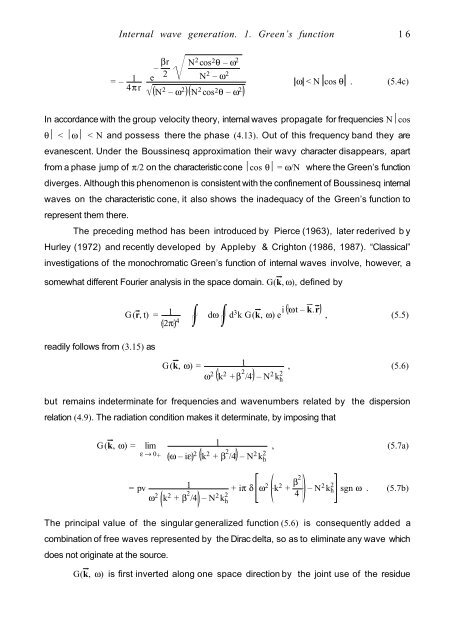Internal Wave Generation in Uniformly Stratified Fluids. 1 ... - LEGI
Internal Wave Generation in Uniformly Stratified Fluids. 1 ... - LEGI
Internal Wave Generation in Uniformly Stratified Fluids. 1 ... - LEGI
You also want an ePaper? Increase the reach of your titles
YUMPU automatically turns print PDFs into web optimized ePapers that Google loves.
= – 1<br />
4πr e<br />
– βr N<br />
2<br />
2 cos2θ – ω2 N2 – ω2 N2 – ω2 N2 cos2θ – ω2 ω < N cos θ . (5.4c)<br />
In accordance with the group velocity theory, <strong>in</strong>ternal waves propagate for frequencies N⏐cos<br />
θ⏐ < ⏐ω⏐ < N and possess there the phase (4.13). Out of this frequency band they are<br />
evanescent. Under the Bouss<strong>in</strong>esq approximation their wavy character disappears, apart<br />
from a phase jump of π/2 on the characteristic cone ⏐cos θ⏐ = ω/N where the Green’s function<br />
diverges. Although this phenomenon is consistent with the conf<strong>in</strong>ement of Bouss<strong>in</strong>esq <strong>in</strong>ternal<br />
waves on the characteristic cone, it also shows the <strong>in</strong>adequacy of the Green’s function to<br />
represent them there.<br />
The preced<strong>in</strong>g method has been <strong>in</strong>troduced by Pierce (1963), later rederived by<br />
Hurley (1972) and recently developed by Appleby & Crighton (1986, 1987). “Classical”<br />
<strong>in</strong>vestigations of the monochromatic Green’s function of <strong>in</strong>ternal waves <strong>in</strong>volve, however, a<br />
somewhat different Fourier analysis <strong>in</strong> the space doma<strong>in</strong>. G(k, ω), def<strong>in</strong>ed by<br />
readily follows from (3.15) as<br />
G(r, t) = 1<br />
2π 4 dω d3 k G(k, ω) e i ωt – k.r , (5.5)<br />
G(k, ω) =<br />
1<br />
ω 2 k 2 + β 2 /4 – N 2 k h 2<br />
, (5.6)<br />
but rema<strong>in</strong>s <strong>in</strong>determ<strong>in</strong>ate for frequencies and wavenumbers related by the dispersion<br />
relation (4.9). The radiation condition makes it determ<strong>in</strong>ate, by impos<strong>in</strong>g that<br />
G(k, ω) = 1<br />
ω – iε 2 k2 + β 2 /4 – N2 lim<br />
ε → 0+<br />
2<br />
kh = pv<br />
, (5.7a)<br />
1<br />
ω2 k2 + β 2 /4 – N2 2<br />
kh + iπ δ ω2 k2 + β2<br />
4 – N2 kh 2 sgn ω . (5.7b)<br />
The pr<strong>in</strong>cipal value of the s<strong>in</strong>gular generalized function (5.6) is consequently added a<br />
comb<strong>in</strong>ation of free waves represented by the Dirac delta, so as to elim<strong>in</strong>ate any wave which<br />
does not orig<strong>in</strong>ate at the source.<br />
<strong>Internal</strong> wave generation. 1. Green’s function 16<br />
G(k, ω) is first <strong>in</strong>verted along one space direction by the jo<strong>in</strong>t use of the residue


